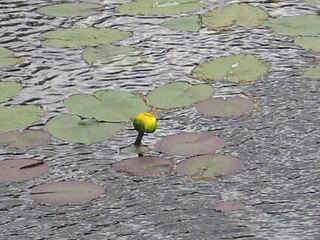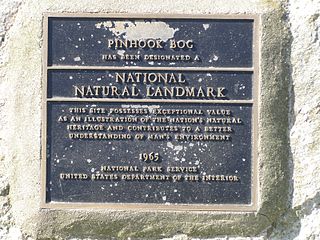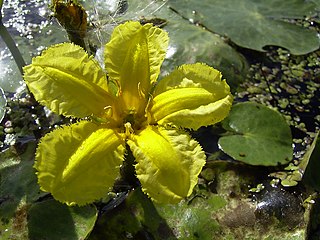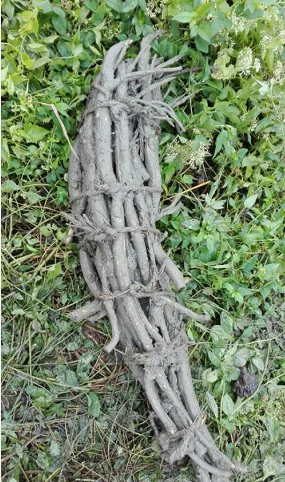
Water garden or aquatic garden, is a term sometimes used for gardens, or parts of gardens, where any type of water feature is a principal or dominant element. The primary focus is on plants, but they will sometimes also house waterfowl, or ornamental fish, in which case it may be called a fish pond. They vary enormously in size and style.

Utricularia, commonly and collectively called the bladderworts, is a genus of carnivorous plants consisting of approximately 233 species. They occur in fresh water and wet soil as terrestrial or aquatic species across every continent except Antarctica. Utricularia are cultivated for their flowers, which are often compared with those of snapdragons and orchids, especially amongst carnivorous plant enthusiasts.

Nelumbo lutea is a species of flowering plant in the family Nelumbonaceae. Common names include American lotus, yellow lotus, water-chinquapin, and volée. It is native to North America. The botanical name Nelumbo lutea Willd. is the currently recognized name for this species, which has been classified under the former names Nelumbium luteum and Nelumbo pentapetala, among others.

Nuphar is a genus of aquatic plants in the family Nymphaeaceae, with a temperate to subarctic Northern Hemisphere distribution. Common names include water-lily, pond-lily, alligator-bonnet or bonnet lily, and spatterdock.

Elodea canadensis is a perennial aquatic plant, or submergent macrophyte, native to most of North America. It has been introduced widely to regions outside its native range and was first recorded from the British Isles in about 1836.

Hottonia palustris, also water violet or featherfoil, is an aquatic plant in the family Primulaceae.

Lobelia cardinalis, the cardinal flower, is a species of flowering plant in the bellflower family Campanulaceae native to the Americas, from southeastern Canada south through the eastern and southwestern United States, Mexico and Central America to northern Colombia.

Nuphar lutea, the yellow water-lily, brandy-bottle, or spadderdock, is an aquatic plant of the family Nymphaeaceae, native to northern temperate and some subtropical regions of Europe, northwest Africa, and western Asia. This species was used as a food source and in medicinal practices from prehistoric times with potential research and medical applications going forward.

Potamogeton crispus, the crisp-leaved pondweed, curly pondweed, curly-leaf pondweed or curled pondweed, is a species of aquatic plant (hydrophyte) native to Eurasia but an introduced species and often a noxious weed in North America.

Pinhook Bog is a unique bog in Indiana that has been designated a National Natural Landmark. It is part of Indiana Dunes National Park, an area that many citizens, scientists, and politicians fought hard to preserve. Its sister bog, Volo Bog, is located nearby. The bog contains a large variety of plants, including insect eating plants, tamarack trees, stands of blueberry bushes, and floating mats of sphagnum moss. Pinhook Bog is about 580 acres (2.3 km2), a quarter of which is a floating mat of sphagnum peat moss. A "moat" separates the bog from the uplands.

Nymphoides peltata is perennial, rooted aquatic plant with floating leaves of the family Menyanthaceae.

Utricularia inflata, commonly known as the swollen bladderwort, inflated bladderwort, or large floating bladderwort, is a large suspended aquatic carnivorous plant that belongs to the genus Utricularia. It is a perennial that is native to the southeastern coastal plains of the United States. It has often been confused with U. radiata, which is similar but smaller than U. inflata. Since 1980, U. inflata has been reported to exist in locations beyond its traditional range, such as the Adirondack Mountains in New York, southeastern Massachusetts, and in Washington State. Studies on the populations in the Adirondacks suggest that an introduction of U inflata. to a location where it naturalizes can lead to altered sediment chemistry by reducing the net primary productivity of native species. It is also listed by the state of Washington as a problematic species because of the dense mat-forming habit of this aquatic Utricularia. It is one of the few carnivorous plants that can be invasive.
Palustris is a Latin word meaning "swampy" or "marshy", and may refer to:

Myriophyllum verticillatum, the whorl-leaf watermilfoil or whorled water-milfoil, is a native to much of North America, North Africa, and Eurasia. It closely resembles another native milfoil, called northern water milfoil Whorled water milfoil is also easily confused with four types of invasive milfoils: Eurasian water milfoil, Variable water-milfoil, Parrot feather, and hybrid water milfoil.

Potamogeton diversifolius is a species of aquatic plant known by the common names waterthread pondweed and diverse-leaved pondweed. It is native to most of the United States, as well as sections of southwestern Canada, and northern Mexico, where it grows in water bodies such as ponds, lakes, ditches, and slow-moving streams. This is a perennial herb producing a very narrow, compressed stem branching to a maximum length around 35 centimeters. It has thin, pointed linear leaves a few centimeters long spirally arranged about the thin stem. The inflorescence is a small spike of flowers emerging from the water surface. Inflorescences also grow on submersed sections of the stem; these are smaller and spherical. It can be difficult to distinguish from similar species of pondweed.

Limnobium laevigatum is a floating aquatic plant, and is a member of the family Hydrocharitaceae. Common names include West Indian spongeplant, South American spongeplant and Amazon or smooth frogbit. This plant was introduced to North American waterways through use in aquariums and aquascapes.

Ranunculus trichophyllus, the threadleaf crowfoot, or thread-leaved water-crowfoot, is a plant species in the genus Ranunculus, native to Europe, Asia and North America.

Hottonia is a genus of aquatic flowering plant in the family Primulaceae. It comprises two species, both of which are known by the common name featherfoil:

A gnat is any of many species of tiny flying insects in the dipterid suborder Nematocera, especially those in the families Mycetophilidae, Anisopodidae and Sciaridae. Most often they fly in large numbers, called clouds. "Gnat" is a loose descriptive category rather than a phylogenetic or other technical term, so there is no scientific consensus on what constitutes a gnat. Some entomologists consider only non-biting flies to be gnats. Certain universities and institutes also distinguish eye gnats: the Smithsonian Institution describes them as "non-biting flies, no bigger than a few grains of salt, ... attracted to fluids secreted by your eyes".

The Jingtang Lotus Root (京塘莲藕) is a pink-flowering aquatic plant. It most likely originated in Jingtang, Huadu District, Guangzhou City, Guangdong Province, where it was cultivated for its vegetative parts and seeds. The most commonly eaten component of the plant is its taproot, although its green leaves are eaten as well. This plant is an aquatic perennial. Under favorable circumstances, its seeds may remain fertile for many years. The oldest lotus germination recorded involved 1,300-year-old seeds which were recovered from a dry lake bed in northeastern China.




















